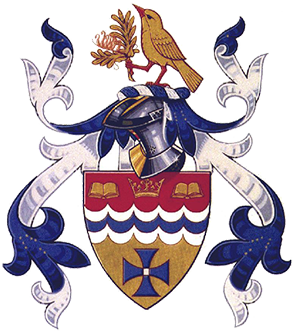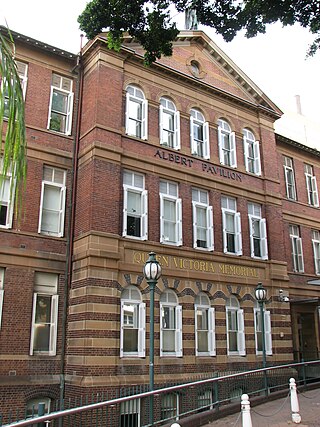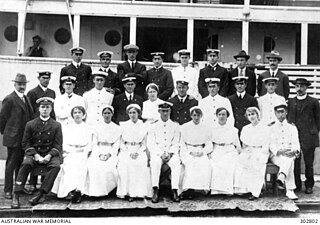
Camperdown is an inner western suburb of Sydney, in the state of New South Wales, Australia. Camperdown is located 4 kilometres south-west of the Sydney central business district and is part of the Inner West region. Camperdown lies across the local government areas of the City of Sydney and Inner West Council.

Sydney Hospital is a major hospital in Australia, located on Macquarie Street in the Sydney central business district. It is the oldest hospital in Australia, dating back to 1788, and has been at its current location since 1811. It first received the name Sydney Hospital in 1881.

Westmead Hospital is a major teaching hospital in Sydney, Australia. Opened on 10 November 1978, the 975-bed hospital forms part of the Western Sydney Local Health District, and is a teaching hospital of Sydney Medical School at the University of Sydney.

Blacktown Hospital is a university teaching hospital in Blacktown, New South Wales, Australia, about 34 kilometres from the Sydney CBD. Together with Mount Druitt Hospital and associated community health centres, it is a part of the Western Sydney Local Health District (WSLHD). The hospital is located in one of the fastest population growth areas in NSW, caring for patients from highly diverse cultural and social-economic status backgrounds.

The Royal Melbourne Hospital (RMH), located in Parkville, Victoria, an inner suburb of Melbourne, is one of Australia's leading public hospitals. It is a major teaching hospital for tertiary health care with a reputation in clinical research. The hospital is managed as part of Melbourne Health which comprises the Royal Melbourne Hospital, North West Dialysis Service and North Western Mental Health. The Royal Melbourne Hospital appointed Professor Shelley Dolan as the new Chief Executive following an international search. She succeeded Professor Christine Kilpatrick AO, who stepped down on 30 June 2023.

The Royal North Shore Hospital (RNSH) is a major public teaching hospital in Sydney, Australia, located in St Leonards. It serves as a teaching hospital for Sydney Medical School at the University of Sydney, University of Technology Sydney and Australian Catholic University and has over 600 beds.

Nursing in Australia has evolved in training and regulation since the 19th century.

The Prince Henry Hospital site, formerly known as the Prince Henry Hospital, Sydney, is a heritage-listed former teaching hospital and infectious diseases hospital and now UNSW teaching hospital and spinal rehabilitation unit located at 1430 Anzac Parade, Little Bay, City of Randwick, New South Wales, Australia. It was designed by NSW NSW Colonial Architect and NSW Government Architect and built from 1881 by NSW Public Works Department. It is also known as Prince Henry Hospital and The Coast Hospital. The property is owned by Landcom, an agency of the Government of New South Wales. It was added to the New South Wales State Heritage Register on 2 May 2003.

Grace Margaret Wilson was a high-ranked nurse in the Australian Army during World War I and the first years of World War II. Wilson was born in Brisbane, and completed her initial training as a nurse in 1908. After the outbreak of World War I she joined the Australian Army Nursing Service (AANS) and subsequently transferred to the First Australian Imperial Force. From 1915 until 1919 she was the principal matron of the 3rd Australian General Hospital. She served as the temporary matron-in-chief in the AIF Headquarters, London from late 1917 until early 1918. Wilson returned to Australia in 1920 and left the AIF to work in civilian hospitals. She was appointed the matron-in-chief of the AANS in 1925, and in September 1940 joined the Second Australian Imperial Force. She served in the Middle East until August 1941, when she returned to Australia due to ill health. She left the Army the next month, but from September 1943 worked in the Department of Manpower Directorate (Victoria)'s nursing control section.
George Allen Mansfield was a prominent Australian architect of the nineteenth century who designed many iconic buildings in Sydney, New South Wales, Australia.
The Heart Research Institute (HRI) is a not-for-profit research facility, originally based in Camperdown, New South Wales, Australia and currently based in Newtown, New South Wales.
Richard Anthony Scolyer is an Australian pathologist. He is a senior staff specialist in tissue pathology and diagnostic oncology at Royal Prince Alfred Hospital, co-medical director at the Melanoma Institute Australia, and Cojoint professor at the University of Sydney.

Susan Bell McGahey was the matron of the Royal Prince Alfred Hospital from 1891 to 1904. McGahey was also co-founder of the Australasian Trained Nurses' Association in 1899 and president of the International Council of Nurses from 1904 to 1909.

The Victoria and Albert Pavilions are jointly heritage-listed public hospital buildings within the Royal Prince Alfred Hospital at Missenden Road, Camperdown, City of Sydney, New South Wales, Australia. The pavilions were designed by NSW Government Architect Walter Liberty Vernon in consultation with Mansfield Brothers and built from 1901 to 1904. They were added to the New South Wales State Heritage Register on 2 April 1999.

The Admission Block, or Administration Building, is a heritage-listed hospital building within the Royal Prince Alfred Hospital at Missenden Road, Camperdown, City of Sydney, New South Wales, Australia. It was designed by George Allen Mansfield of Mansfield Brothers and built from 1876 to 1882. It was added to the New South Wales State Heritage Register on 2 April 1999.
John Stephen Horvath is an Australian medical doctor and the Chief Medical Officer of Australia between 2003 and 2009. As of June 2020 Horvath is Deputy Chairman of Crown Resorts Limited. Horvath is also Group Chief Medical Officer of Ramsay Health Care and a Director of the Ramsay Hospital Research Foundation and the Gallipoli Medical Research Foundation.

Muriel Knox Doherty, was an Australian nurse who served as a matron in the Royal Australian Air Force Nursing Service during the Second World War and then as a member of the United Nations Relief and Rehabilitation Administration in the Bergen-Belsen concentration camp in Germany.
The Australasian Trained Nurses' Association was an association formed in 1899 to register nurses who had been trained in Australia.

Isla Stuart Blomfield was an Australian nurse, sanitary inspector, and health visitor. She spent her career helping to reduce the high infant mortality in New South Wales advising mothers about breast feeding. She was the only woman health inspector in Sydney's health department, and she was an executive member of the Royal Society for the Welfare of Mothers and Babies.

Rosa Angela Kirkcaldie CBE was an Australian hospital matron, writer and army nurse. She served as a nurse throughout the first world war and then became a celebrated matron at the Royal Alexandra Hospital for Children.






















